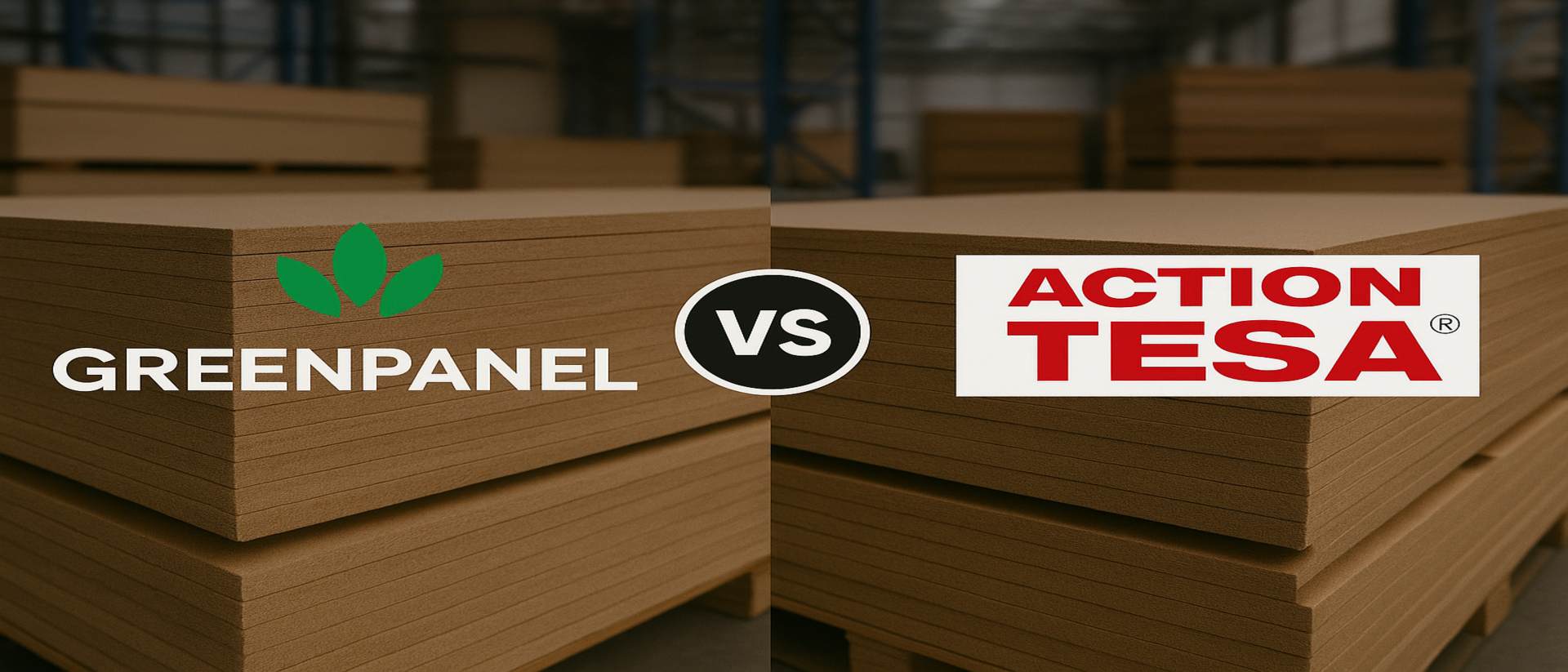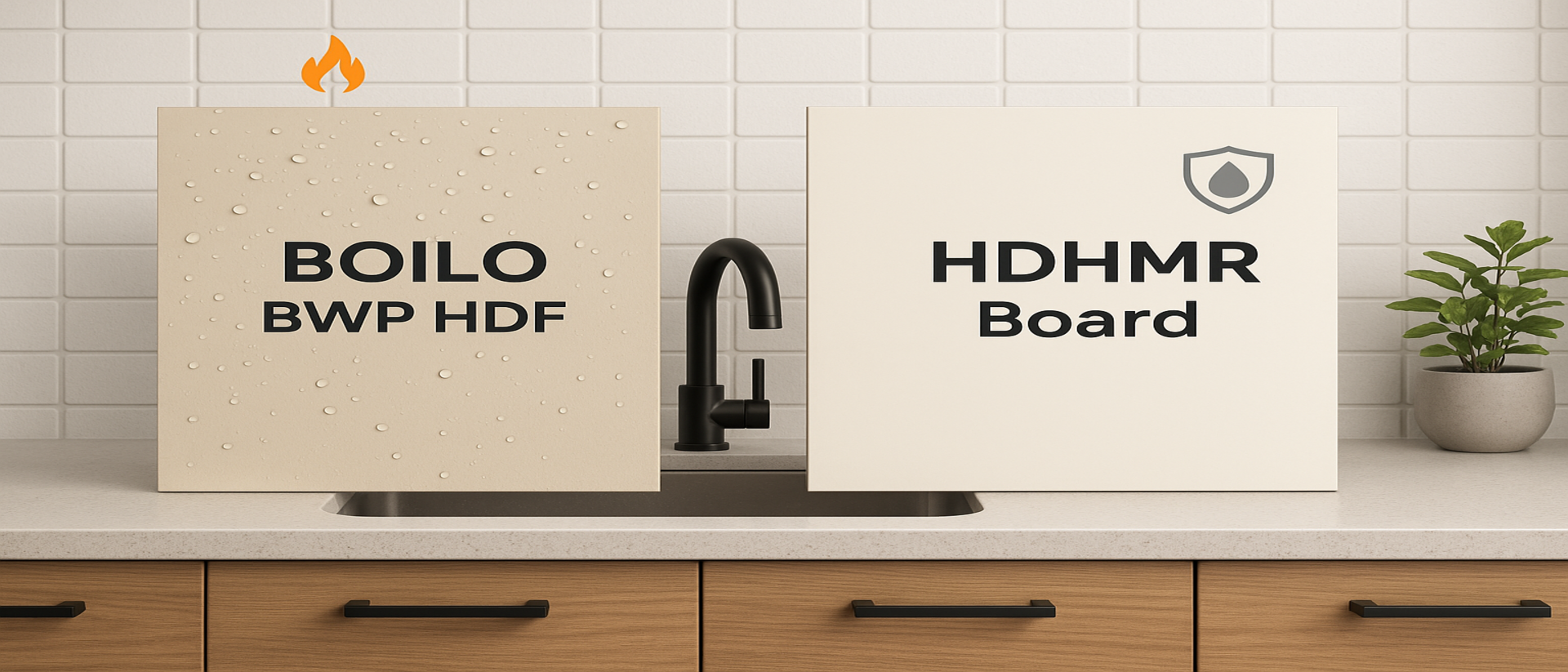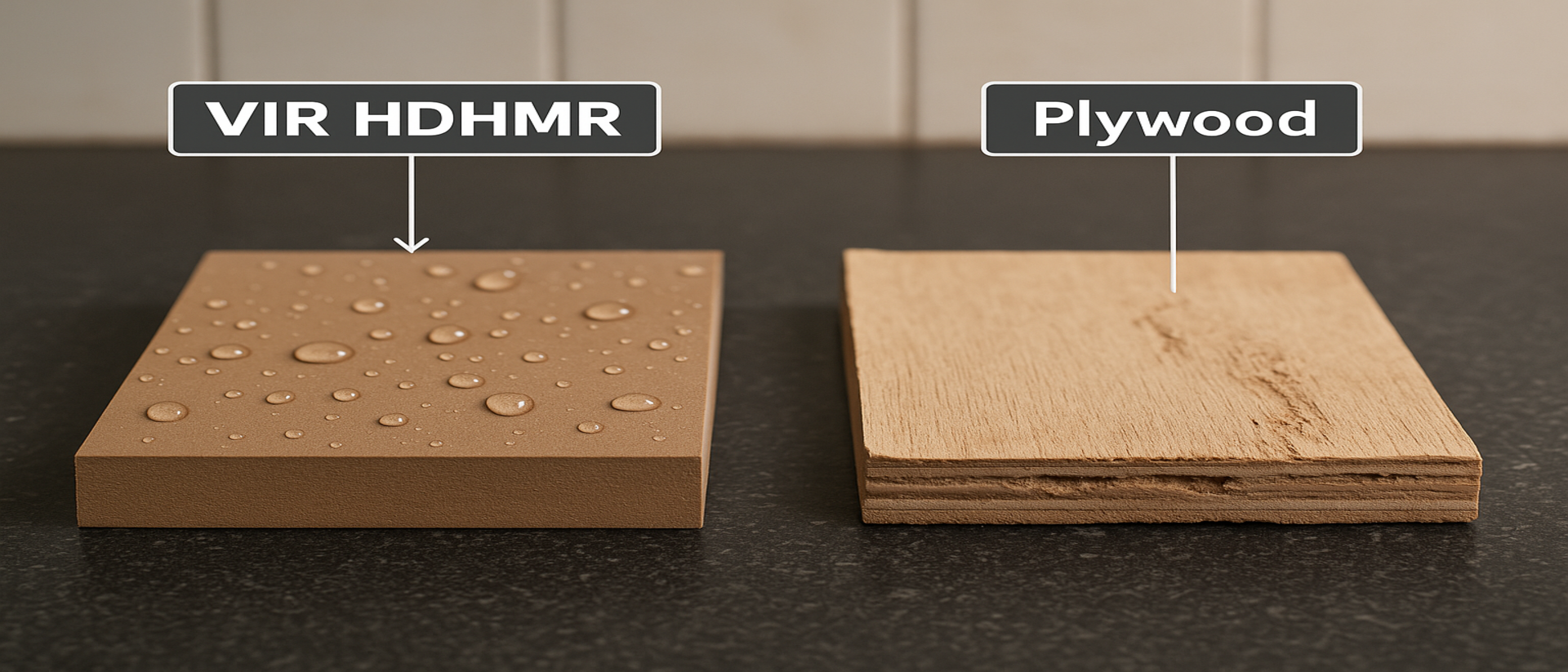When planning to build or buy furniture, one important decision is choosing the right board material. Two popular engineered boards are MDF (Medium Density Fiberboard) and HDHMR (High Density High Moisture Resistance) board. They might appear similar at first – both are smooth, fiber-based boards – but they have distinct properties. In this guide, we’ll compare HDHMR vs MDF in the context of furniture making, covering their composition, strength, moisture resistance, lifespan, and cost to determine which is better suited for various furniture needs.
Composition & Manufacturing
· MDF (Medium Density Fiberboard): MDF is made by breaking down hardwood or softwood residuals into fine fibers, then mixing with wax and resin and pressing into panels under heat. The result is a uniform, medium-density board (typically ~600–800 kg/m³ density). MDF has a smooth surface and no grain, which makes it easy to cut and finish. However, standard MDF is not moisture-resistant – it readily absorbs water because the fibers are not specially treated. MDF is great for paint or laminate finishes due to its flatness, but it swells and weakens if it gets damp. It’s commonly used in indoor, dry applications or low-cost furniture where high strength isn’t critical.
· HDHMR (High Density High Moisture Resistance) Board: HDHMR is essentially an upgraded version of HDF/MDF. It uses a similar process but with hardwood fibers and specially formulated resins that impart moisture resistance. The pressing is done at higher pressure, achieving greater density (often >800 kg/m³). HDHMR boards include additives or adhesives (like water-repellent resins) that make the finished board resistant to moisture and termite attack. In essence, HDHMR boards were developed to overcome MDF’s weaknesses – giving a board that is denser, stronger, and can handle humid conditions without damage. Think of HDHMR as “MDF 2.0” optimized for durability.
Strength & Durability
HDHMR is significantly stronger and more durable than standard MDF, which is a key factor for furniture:
· Density & Load-Bearing: HDHMR’s density is high – often around 850 kg/m³ or more, whereas MDF might be ~700 kg/m³. This higher density translates to better mechanical strength and screw holding capacity. For example, screws in HDHMR have less chance of stripping out; hinges on HDHMR cabinet doors stay firm over time. MDF, being softer, can lose screw tension if over-tightened or with heavy use. For bookshelves or wardrobes bearing weight, HDHMR shelves will sag less than MDF of the same thickness.
· Moisture Resistance & Termite Resistance: Regular MDF is very susceptible to swelling if it contacts water or even high humidity over time. HDHMR, on the other hand, is made to resist moisture penetration. The “HMR” in HDF-HMR stands for High Moisture Resistance, meaning the board can handle kitchen or bathroom humidity without warping or fungal growth. Additionally, HDHMR boards are treated to be termite and borer proof, a big advantage in Indian climates. MDF generally is not termite-proof (unless one buys a special variant with chemical treatment). For furniture that might face moisture (kitchen cabinets, bathroom vanities, even a closet against a damp wall), HDHMR is far superior – it won’t develop swelling or mold spots like MDF might.
· Lifespan: Given the above, furniture made with HDHMR tends to have a longer expected life, especially in less-than-ideal conditions. MDF furniture has a moderate lifespan (perhaps 5–10 years) if kept dry and not overstressed. HDHMR furniture can easily last 10–15 years or more, since it handles stress and moisture better. In fact, HDHMR’s durability in humid environments gives it a clear edge – for example, a kitchen made with MDF might start showing swelling or sagging after a few monsoons, whereas an HDHMR kitchen remains intact.
· Surface Hardness: HDHMR’s higher density also means a harder surface that is more resistant to dents or damage. MDF is relatively soft; edges can dent if knocked. HDHMR’s compact core can take more impact (though both are not as hard as solid wood in that sense). For tabletops or surfaces, HDHMR will resist impressions better.
Workability & Finish
Both MDF and HDHMR are easy to work with in terms of cutting, machining, and finishing, but there are slight differences:
· Cutting/Machining: MDF is very uniform and cuts easily with saws or CNC routers, but it produces a lot of fine dust. HDHMR, being denser, is a bit heavier to cut through but still machines well and also produces fine dust. One advantage of HDHMR is its “routing characteristics” – manufacturers note it has a compact core ideal for CNC carving or router patterns without chipping. MDF can fuzz or chip at the edges when routed if tools are dull, whereas HDHMR yields cleaner cuts due to the special resins and compact fiber bond. Carpenters find both materials far easier for making intricate shapes than plywood (which can splinter along the grain).
· Finishing (Painting/Laminating): MDF has a smooth paint-grade surface and is often used for painted furniture or interior units. It takes paint well (with proper priming) and results in a very smooth finish. HDHMR also has a smooth surface and can be painted or laminated just like MDF. The difference is, HDHMR’s surface resists moisture during finishing – for instance, water-based paints or glue for laminates won’t cause it to swell. HDHMR boards typically come with a pre-sanded, pre-sealed surface, so they might even need less priming for paint. In practice, both materials can achieve a top-notch finish (high gloss, matte, veneer, etc.), but if you plan to paint furniture, MDF and HDHMR are on par – just ensure edges are well-sealed in either case. One source explicitly confirms: “HDHMR boards boast a smooth, even surface that takes paint, laminate, or veneer exceptionally well”. This means your furniture’s aesthetic can be equally great with either material.
· Joining: Both MDF and HDHMR can be joined with screws, dowels, or fasteners, but as noted earlier, HDHMR holds screws tighter. When using MDF for furniture, carpenters often reinforce joints with glue blocks or use special confirmat screws to ensure strength. HDHMR’s additional screw strength might reduce the need for such measures in medium-duty pieces. Adhesives (like Fevicol SH) work well on both MDF and HDHMR for laminating or edge banding tasks. Due to its resin content, HDHMR can sometimes be slightly more resistant to glue penetration, but using a good quality adhesive ensures a strong bond on both.
Ideal Uses in Furniture
MDF is best for:
· Low-cost or indoor-only furniture where moisture exposure is minimal. E.g., bookshelves, display cabinets, dresser drawers in bedrooms, wall-mounted units in dry rooms, etc., especially when a painted finish is desired.
· Intricate carved or decorative panels, as MDF is homogeneous and easy to rout for designs (though HDHMR can do this too, MDF is cheaper for purely decorative pieces).
· Furniture that won’t bear very heavy loads. MDF is fine for a coffee table, but for a large wardrobe or modular kitchen, its strength might be lacking unless thick panels are used.
HDHMR is best for:
· Kitchen cabinets and bathroom vanities, or any furniture in humid or semi-moist conditions. HDHMR was practically made for kitchens – it withstands the heat and moisture and won’t get termite-infested like normal plywood might. Many modular kitchen companies in India have started offering HDHMR carcasses for longevity.
· Wardrobes or storage units that back onto damp walls or are in coastal areas. The moisture resistance ensures the unit doesn’t warp over seasons.
· High-strength requirements: large bookshelves, office furniture, or wardrobes where heavy items will be stored. HDHMR’s rigidity ensures the shelves and frames remain straight. Also, for items like door shutters on cabinets that get frequent use, the hinge areas in HDHMR will stay intact longer.
· Outdoor or semi-outdoor furniture frames: While direct outdoor use of HDHMR still requires proper sealing (and is not as ideal as solid teak or marine ply), some people use HDHMR for things like garage cabinets, outdoor bar units, or signage because it tolerates temperature changes and moisture far better than MDF. If protected with paint/laminate, HDHMR can survive occasional rain exposure (MDF would ruin quickly).
Cost Considerations
Cost can often be the deciding factor:
· MDF is generally cheaper than HDHMR. In India, standard MDF board of 18mm might cost in the range of ₹20–₹50 per sq ft depending on brand and quality. HDHMR boards of 18mm typically range around ₹60–₹100 per sq ft. In other words, HDHMR can be roughly 1.5 to 2 times the price of MDF of equivalent thickness. This is because of the superior resins and manufacturing tech involved. For a large piece of furniture, this cost difference can add up.
· However, using MDF in areas where it fails can be a false economy. For example, if an MDF kitchen starts swelling or needs replacement in 5 years, whereas HDHMR would have lasted 15 years, the life-cycle cost of HDHMR is lower. So, for critical pieces (like kitchen or expensive wardrobe), many consider the higher initial cost of HDHMR worth it.
· Also note, there are Moisture Resistant MDF (often called HDF-HMR) boards in the market that fill the gap somewhat – these are priced between normal MDF and full HDHMR. But true HDHMR (with highest density and performance) is a premium product. Brands like Action Tesa, Century, and Rushil (Vir) produce HDHMR boards and they price them closer to premium plywood.
Conclusion: Which is Better for Furniture?
For most furniture applications in Indian homes, especially in kitchens or places with any humidity, HDHMR is the superior choice over MDF. The exceptional strength and moisture resistance of HDHMR make it a more robust, longer-lasting material. If you’re building a wardrobe, modular kitchen, bathroom cabinet, or any furniture that you want to endure wear and tear, HDHMR will give you peace of mind. It won’t sag under heavy loads and won’t be ruined by a bit of moisture or pests.
On the other hand, MDF is better suited for low-budget projects or decor elements – e.g., a painted console table in a dry room or wall shelves for light items. It provides a smooth finish at a low cost and is easy to fabricate for DIY projects. Just avoid MDF in critical structural parts or wet areas.
In summary:
· Choose HDHMR for furniture that demands durability – you’ll get a longer lifespan, even in kitchens and bathrooms, and stronger performance (screw holding, no warping).
· Opt for MDF for budget-friendly, indoor-only furniture or decorative pieces where high strength isn’t required. Always seal and paint MDF properly to get the best out of it, and keep it away from water.
By weighing these factors, you can make the right material choice. Many modern Indian homeowners and carpenters are now leaning towards HDHMR for its reliability, even if it costs a bit more upfront, because the furniture “survives” daily use much better. The investment in HDHMR often pays off in the quality and longevity of the final product – which is why it’s increasingly touted as the better choice for furniture that lasts.
Disclaimer: This article is generated using AI-assisted research and is intended for informational purposes only. While we strive for accuracy, readers are advised to verify all technical, pricing, and brand-specific details with official sources. hdhmr.in is not liable for any decisions made based on this content.




